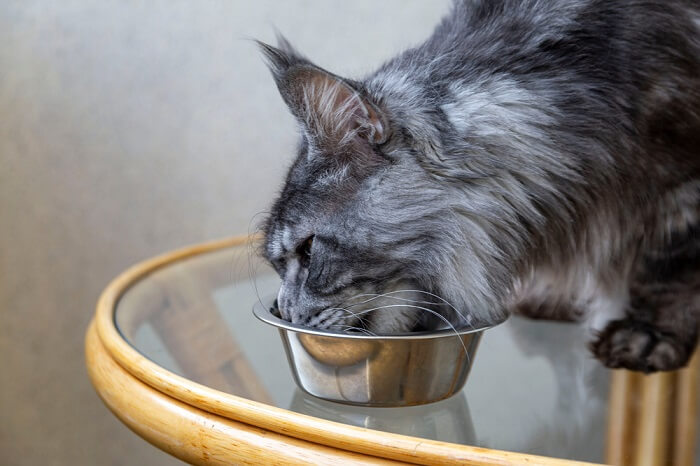
Capromorelin is a liquid oral solution medication used for appetite stimulation in dogs and cats. Currently, there are two brands of medication used for pets, both developed and manufactured by Elanco Animal Health. Entyce is the product FDA approved for dogs.
Capromorelin For Cats Overview

Elura, which recently became available in 2020, is FDA approved for use in cats. In this article, you’ll learn how capromorelin works including more info about the Elura product, potential side effects, and frequently asked questions.
About Capromorelin for Cats
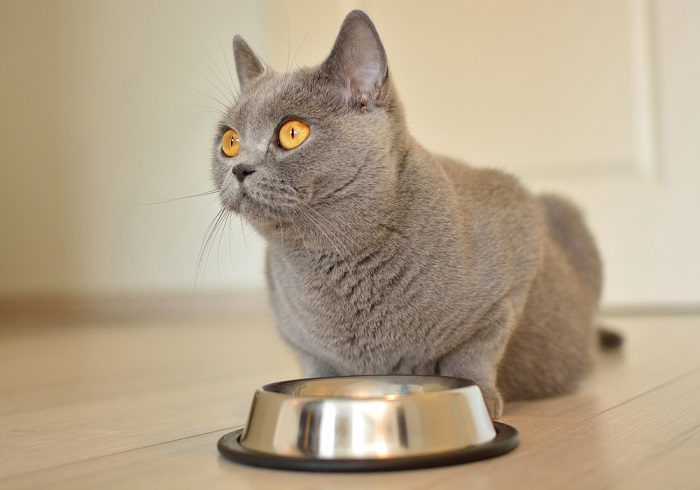
Capromorelin is classified as an appetite stimulant and is used to increase the appetite of cats experiencing poor appetite or weight loss. Elura specifically is FDA approved for use in cats with chronic kidney disease (CKD) to help them gain weight.
Also Read: Kidney Failure In Cats: Symptoms, Diagnosis, & Treatment
Capromorelin is a ghrelin-receptor agonist, or stimulator, which in turn stimulates growth hormone release, causing the feeling of hunger that leads to stimulation of appetite.
Ghrelin is a natural hormone in the body, and capromorelin essentially mimics part of the pathway leading to its release. Interestingly, ghrelin has also shown to have some other beneficial effects as well, including stimulating bone formation, increasing muscle mass, and exhibiting some anti-inflammatory and immune system modulating effects.
What Does Capromorelin Do for Cats?
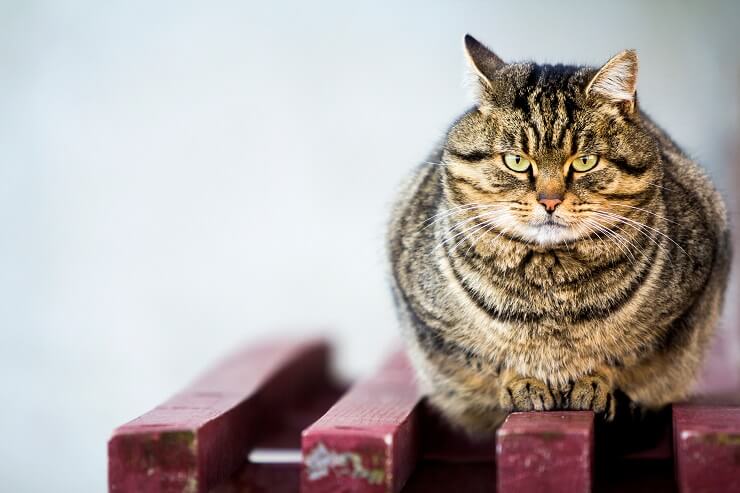
In field studies involving about 120 cats given Elura showed a 5.2% increase in body weight after 8 weeks.
Capromorelin is the only FDA approved appetite stimulant available for cats.
The cat-specific product Elura was studied in cats with chronic kidney disease (CKD). In field studies involving about 120 cats given Elura, a 3.3% increase in body weight was seen after 2 weeks with a 5.2% increase after 8 weeks.
Side Effects of Capromorelin for Cats
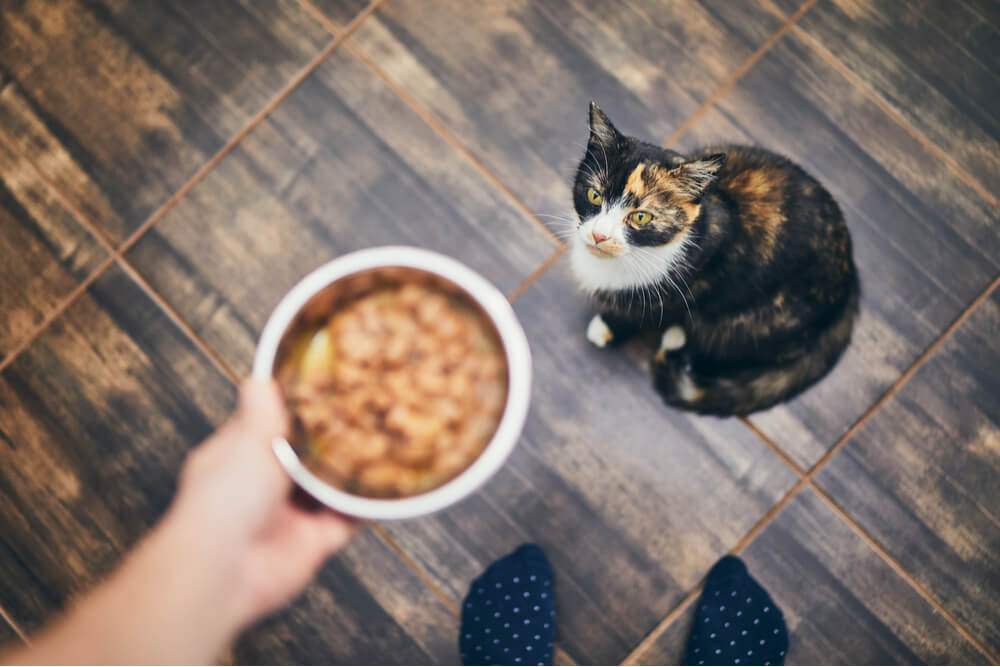
Capromorelin is generally considered to be well-tolerated by most cats. The most common side effects seen during the study of cats with CKD included vomiting, hypersalivation (drooling), inappetence, behavior change, and lethargy. Just under 30% of cats were observed to have some vomiting, with other frequencies being lower. All other adverse reactions listed were seen in less than 10% of cats.
The cats in the CKD study in which capromorelin was used were 15 years of age on average and most had one or more other diseases or conditions besides CKD. This included diseases like hyperthyroidism, heart disease, Feline Gingivitis, and high blood pressure.
The safety of Elura for both longer durations of treatment as well as exceedingly high doses has been evaluated.
Cats receiving Elura at 3 times the labeled dosage for up to 90 days tolerated treatment well and exhibited no ill health effects. Cats receiving up to 30 times the labeled dosage for 2 weeks experienced a higher frequency of vomiting, drooling, and lethargy, but no other ill effects.
Cautious use of Elura is advised in cases of cats with heart disease, liver dysfunction, and severe dehydration. Because it acts on growth hormone, its use should be avoided in cats diagnosed with the rare condition acromegaly, where the body is producing too much of its own growth hormone already.
Because Elura was found to increase blood sugar for several hours after administration in some cats, its use in diabetic or prediabetic kitties should be considered carefully and may not be appropriate.
Also Read: Feline Diabetes: Diagnosis, Treatment, and Remission Demystified
When administering any oral solution to a cat, it’s important to remember that cats are very sensitive to taste and may experience a bitter taste type of reaction. While possibly not true side effects, signs like vomiting, increased salivation, lip smacking, and head shaking immediately after administration, but resolving within a few minutes, may be seen due to a taste response.
If you have any concerns for potential toxicity resulting from use of Elura, it is always best to contact your veterinarian, the ASPCA Animal Poison Control Center (1-888-426-4435), or Pet Poison Helpline (1-855-764-7661) for further advice.
Capromorelin for Cats Dosage
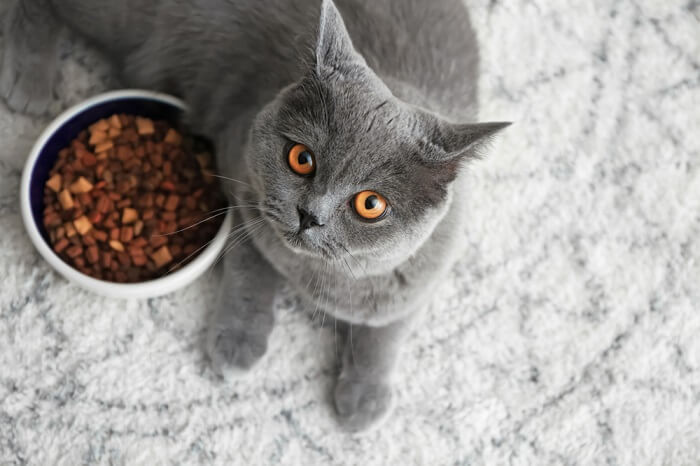
Even though there are no limitations stated for the duration of usage of Capromorelin in cats, most appetite stimulants should only be used as needed.
The FDA approved dosage for cats for Elura is 2mg/kg (0.9mg/lb) or 0.1ml/kg (0.045ml/lb) of body weight once daily. There is no limitation stated in terms of how long Elura can be used.
However, most appetite stimulants should only be used as needed. Your veterinarian can provide the best guidance in terms of how long Elura should be used and how often.
There is no age limitation stated for Elura either, however, it has not been studied in cats less than 5 months old. It also has not been evaluated for use in pregnant or lactating queens.
The Elura bottle comes with its own dosing syringe and instructions for use. Following is a summary of how to administer Elura based on the manufacturer’s information.
The cap must first be removed. The dosing syringe should be inserted into the hole in the top of the bottle. The bottle is then turned upside down with the syringe inserted.
With the bottle upside down, the syringe plunger is then pulled back to withdraw the correct volume of solution. The bottle is returned to an upright position, the syringe is removed, and the cap is replaced.
To administer the solution, it must be squirted directly into the cat’s mouth. This can best be accomplished by having your cat sit on your lap facing away from you.
Insert the syringe into the corner of your kitty’s mouth until s/he opens the mouth on reflex. Use this opportunity to insert the syringe further and push down the plunger to expel the solution.
If your cat is difficult to medicate, talk to your veterinarian about methods that may work best. Sometimes wrapping your kitty in a towel (commonly referred to as a “kitty burrito”) can help to calm and immobilize some cats long enough to administer an oral medication.
Elura is best given on an empty stomach 30 minutes prior to feeding. According to dosing studies, it may have a delayed onset of action if given with a meal. It likely may have reduced efficacy if the solution is simply squirted onto a cat’s food in the hopes that s/he will ingest the solution while eating food.
The manufacturer recommends redosing Elura if a kitty vomits within 15 minutes of the first administration.
Conclusion
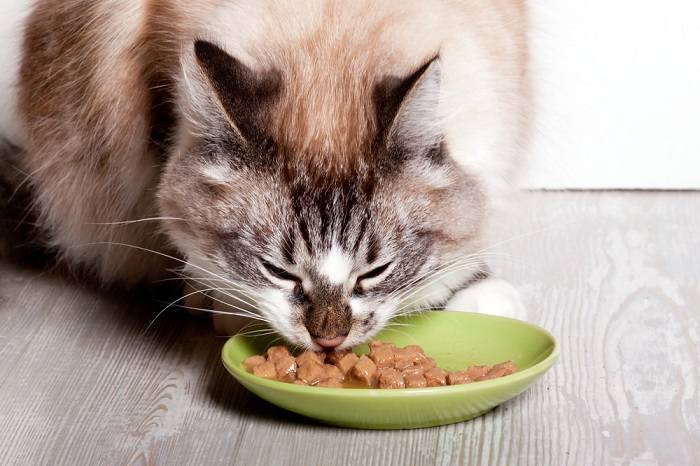
Elura is an extremely helpful medication to use to help cats suffering from weight loss, poor weight gain, or an overall decreased appetite.
Currently, it is the only FDA approved appetite stimulant available for cats. Its only downside may be that some cats are adverse to liquid medications.
Frequently Asked Questions
Can Entyce Be Used in Cats?
Entyce is the FDA approved capromorelin product for dogs. Currently, with Elura on the market, there is much less of a need to consider using Entyce in cats.
According to veterinary oncologists Chad Johannes and Margaret Musser in an article they co-authored titled “The Use of Capromorelin for the Clinical Problem of Inappetence” published in Today’s Veterinary Practice in 2019, a dose of capromorelin, presumably Entyce (as it was the only capromorelin product available at the time), could be used at 2mg/kg once daily. It should be noted that at the time the article was written, Elura was not yet on the market.
Use of Entyce is no longer necessary with Elura now available, which has dosing and safety studies available specifically for cats. If you have Entyce at home for a pup and wish to use it for your cat, you would need to discuss this with your veterinarian, as this would be considered extra-label use of Entyce.
How Long Does Mirtazapine Take to Work in Cats?
Prior to capromorelin products being available, mirtazapine was one of the only appetite stimulants available to use for cats. In the author’s experience, a cat’s appetite should be seen to increase within a couple hours of administration of an appropriate dose of the oral tablet form. Effective dosing of mirtazapine has been found to be about once every 48-72 hours for many cats.
The transdermal form of mirtazapine (the brand Mirataz made by Dechra) may take up to 16 hours to reach its peak concentration with the first dose, but only about 2 hours after subsequent daily doses.
By comparison, Elura reaches its peak concentration in about 15 to 60 minutes, so may be found to work much faster.
When deciding which appetite stimulant to use, it may often come down to what is most convenient for dosing. Mirtazapine tablets only need to be given once every 48 hours at the most often for a cat. In cases where an oral medication is not reasonable for a particular kitty, the transdermal Mirataz can be very helpful. But, if a kitty doesn’t mind a liquid solution, and a quicker onset of action is desired, Elura may be best.
Most veterinary practices will carry at least two of these products if not all three, so make sure to discuss the options and their benefits/detractors with your veterinarian.

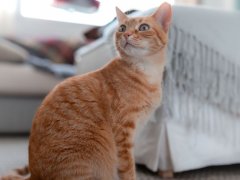
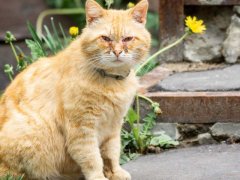


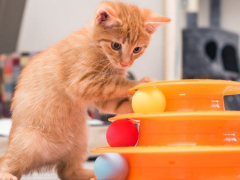


Hello, please help me, I have a cat with anorexia , We have tried all the medicines accesible in Europe, without effect. I´m sure that Elure is that , what he needs. But we can´t buy it without medical prescription, could you help me, I´m GP doctor and I kive in Spain, but I have also family en USA, who could recive Elure, best regards , kasia
Hello Kasia, apologies for the late reply. You may be able to get an international prescription from a veterinarian doing telehealth through a service like whiskerDocs. Hope this helps.
My cat was getting better but not eating on his own, so my vet prescribed Capromorelin for appetite stimulation. After giving him a dose, my cat started drooling and got so lethargic and he died!!!!! This medication will make your cat drowsy beware.
Hi Michele,
I’m so sorry to hear that your kitty passed away so suddenly. It’s heartbreaking to hear that and there’s nothing worse than an unexpected loss, especially when things looked like they might be turning around.
Because a lack of appetite can occur in cats with a variety of illnesses which may have varying severity, and because Elura may be used in many of these cases to try to help, it’s hard to say how it may have contributed.
The hypersalivation can be seen after Elura, and has been reported often enough, as well as the signs of lethargy.
However, these signs are typically transient and resolve. The hypersalivation, usually within a few minutes and the lethargy typically within a couple hours. It’s hard for me to comment further because I don’t know what your cat’s underlying condition was, or how severe it truly was.
Although your cat may have shown signs of improvement, there could have still been concerning disease present that contributed. Some bad diseases can take a turn for the worse rather quickly.
There are many drugs that have to be used carefully in debilitated animals, as their bodies may not be able to handle even the mild effects on the body that mildly or moderately ill pets may be able to tolerate with no problem.
Unfortunately, sometimes a state of illness is worse on the inside than a pet is showing us on the outside and since a disease state is constantly in motion, even the best judgment cannot predict a sudden change or worsening.
Sincere condolences to you on your loss.
My cat is completely delicious after just one dose of Elure. He can’t even walk. Keeps gagging. Super scary!!! It is Friday night. I hope we get through this. I wished I had never given this to him completely opposite to what I expected. He is absolutely miserable. Do not give this to your cat! Please!!!!! I hope he is not going to die!!!
Hi Susanne,
I’m sorry to hear your cat may be having adverse effects from Elura. I can’t be sure, as I don’t know the underlying cause of your cat’s poor appetite, so your cat’s underlying disease condition causing poor appetite could also be related.
Please remember, while Elura is safe for use in most cats, no medication is 100% safe in all cats. Mild effects associated with taste can be common. Signs of weakness and lethargy as you’re describing are less common but can be more serious. These signs can occur within one hour of an Elura dose, associated with low heart rate and blood pressure effects. If these types of more serious side effects are seen, it would be advised to seek follow-up veterinary care as soon as possible.
My cat had kidney disease my vet prescribed elura, and she stopped walking after the first dose and died next day. Becaful elura kill your cats
Hi there. I’m sorry about the loss of your cat. I would be sure to talk with your vet about this incident and look into whether or not it was actually Elura that caused your cat’s death—I’ve not seen any research suggesting that Elura presents a risk of this type of reaction, but your vet will be able to help you figure it out.
My 6 year old cat has been battling kidney disease for 5 years. Over the last 3 months she had lost weight but stabilized at 8 pounds. Over the last few weeks her appetite (which was voracious) has lessened and she is now down to 7.2 pounds. I had been giving her the Mirataz but it stopped working. Today my vet (who has told me she can’t help my cat any further) sold me a prescription of Elura. My cat goes to the vet three times a week for fluids because she cannot drink enough water. I am concerned that the Elura may not be good for her because she is being treated for dehydration. However I need to try something because she has gone from 7.82 pounds to 7.2 pounds in just 2 weeks. Can you tell me if you advise using Elura for her. She has no other medical conditions.
Hi Sharon,
We always have to consider risks vs. benefits with any medication. Elura is labeled for use in cats with chronic kidney disease (CKD) to help with weight loss management. Most cats with CKD tolerated the medication in field studies and did gain weight.
Side effects are possible with Elura as with any medication. Some cats may be more sensitive to it than others. Although it should be used cautiously in pets that are dehydrated, all cats with CKD experience some dehydration, and at least your kitty is having that addressed with the fluids. A bigger concern for the medication may be a cat that has CKD that is unstable or poorly managed.
Most cats that exhibit side effects appear to exhibit them initially with a first dose. If your vet has already prescribed Elura, it may be worth giving an initial dose to see how she tolerates it and what effect it has on her appetite.
If you feel uncomfortable about the potential for side effects, you could give it on a day you’ll be going to your vet for fluids. That way, if there are any concerns after giving an initial dose, those concerns could be assessed.
Thank You for your quick reply. I will do as you suggested and give her her first dose tomorrow- the next day she goes for her fluids. Hopefully she will do well on the medication and gain weight without any ill side effects. Thank You again.
My cat (14.5 years old) has CKD. While Mirataz has been effective in increasing his eating, I want to investigate changing appetite stimulants because the drug has caused him ear irritation, scaling, a small amount of external fur loss on the ear, and obvious discomfort. Mirataz has a warning to avoid touching the cat for at least 2 hours after administration. Does Elura have any such warnings? Are there any steps we humans should use when or after administering Elura?
Hi Gail,
The effects you’ve seen can certainly happen when using Mirataz regularly. I saw those same effects on my own kitty’s ears after using it for some time.
If mirtazapine is working well for your kitty, you can ask your vet about changing over to oral mirtazapine tablets for a period of time to give the ears a rest.
The reason Mirataz has the warning not to touch the area of application for two hours (and why it should be applied with a gloved finger) is because as a transdermal medication, it can be absorbed through your own skin too.
Elura is another appetite stimulant option. It is an oral medication, and so the above warnings for Mirataz do not apply.
Elura can work well too but requires direct oral administration by mouth and some cats do not like the taste.
Often, what you choose as an appetite stimulant depends on what administration method is the least stressful for you and your cat.
Thanks a lot for your detailed and prompt reply! I greatly appreciate your taking the time to help a fellow cat lover. The whole CKD journey has been stressful and frightening, but your input has been reassuring and helpful.
I had been using Mirtaz on my kitty. She started having excessive ear irritation which caused much redness and pain. She would not let me touch her ears at all.
So I asked a compounding pharmacy if they make this in a base that would not be so irritating to my cat’s ear.
YeS, the pharmacy told me. So I had my vet call a prescription to the pharmacy and this formulation did not irritate her ear at all.
Just wanted to let others know about this option in case you do not want to give an oral tablet. Cost about the same as the commercially available Mirtaz and got a larger tube to boot.
Hi Nona,
Thank you for sharing your experience. Mirataz can cause the irritation on the ears you describe in some cats. In my experience, it appears to happen with more chronic/long-term use.
Compounding options can be very helpful. There is a lot of variability in terms of formulations and it really depends on the pharmacy as to what is available and what they can make. Absorption, potency, etc., may vary a lot between preparations, so we can’t comment specifically on these options in our medication articles, but thank you for sharing how this option has been helpful for you and your kitty.
I was supposed to give my cat 0.15 and I gave her 2.5 what should I do?
Hi Kristi,
The best thing to do is to contact one of the following for further advice: ASPCA Animal Poison Control Center (1-888-426-4435), or Pet Poison Helpline (1-855-764-7661) and if you’re seeing any signs of concern in your cat try to get them to an urgent are or ER. Based on my reverse math and assuming the 0.15ml was the labeled dose, if your cat is really about 3lb they may have received about a 30mg/kg dose with the 2.5ml. While doses of 6mg/kg (3x the labeled dose) did not show side effects in trials, doses up to 60mg/kg did contribute to digestive upset effects like vomiting, drooling, and lethargy. Your kitty may have received a dose somewhere in the middle, which is still very high. Contacting one of those numbers above will provide specific information on what to do and the toxicologist can provide a veterinary care provider with specific instructions for care.